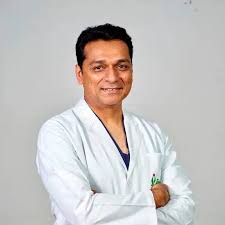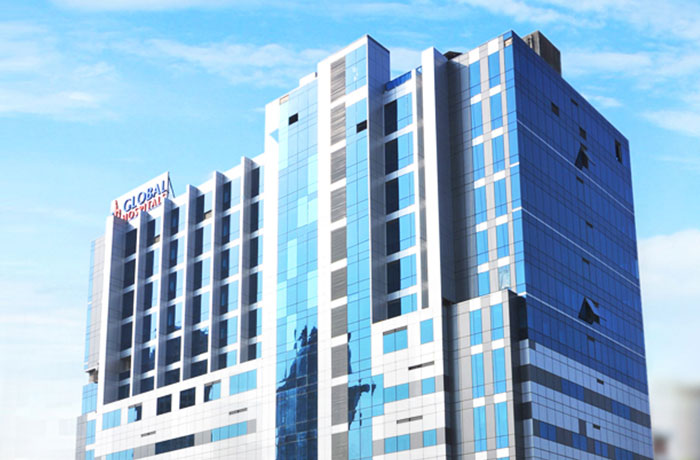Orthopaedic
Scoliosis Treatment
Scoliosis
A person who has scoliosis will have a C- or S-shaped curve in their spine. It can appear at any age, but it is generally present from the age of 10 to 12 years, or during the teens, but even infants can sometimes have symptoms. The reasons for the change in shape are not known, but some cases are linked to muscular dystrophy, spina bifida, cerebral palsy, or a birth defect.
What is Scoliosis?
A person who has scoliosis will have a C- or S-shaped curve in their spine. It can appear at any age, but it is generally present from the age of 10 to 12 years, or during the teens, but even infants can sometimes have symptoms. The reasons for the change in shape are not known, but some cases are linked to muscular dystrophy, spina bifida, cerebral palsy, or a birth defect. A structural curve is permanent and maybe because of another condition. A nonstructural curve is temporary and it is very likely to disappear with time. Children who have mild scoliosis are monitored very closely, generally with X-rays, to see if the curve is getting worse or not. In many cases, no treatment is required. Some children will be required to wear a brace to stop the curve from further worsening.
What causes Scoliosis?
In as many as 80% of cases, doctors don’t find the particular reason for a curved spine. Scoliosis without a known source is known as “idiopathic.” Some kinds of scoliosis do have clear sources. Doctors generally divide those curves into two kinds - structural and nonstructural. In nonstructural scoliosis, the spine works normally, but looks curved; there are a number of reasons, for this occurs such muscle spasms, inflammations like appendicitis, and as one leg’s being longer than the other. When these causes are treated, this type of scoliosis generally goes away. In structural scoliosis, the curve of the spine is rigid and hence can’t be reversed.
Causes include: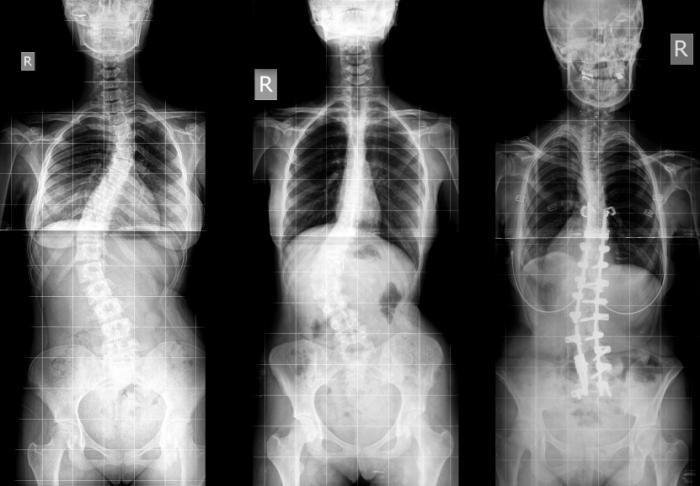
- Cerebral palsy
- Muscular dystrophy
- Defects from birth
- Infections
- Tumors
- Generic conditions like Down syndrome and Marfan syndrome
Risk factors
- Age: Signs and symptoms generally begin during the growth spurt that occurs just before the puberty.
- Sex: Both the boys and the girls develop mild scoliosis at about the same rate, girls have a much higher chance of the curve worsening and thus requiring a treatment.
- Family history: Scoliosis can run in families, but most of the children with scoliosis don't have a family history of this disease.
Symptoms in adolescents
The most frequent form of scoliosis appears in the adolescent. It is called adolescent idiopathic scoliosis. It can affect children who are 10 years old or above. Idiopathic means that there is no known source. Symptoms can include:
- The head is somewhat off center
- The ribcage is not symmetrical, the ribs may be at various heights
- One hip is more noticeable than the other
- Clothes don’t hang properly
- One shoulder, or shoulder blade, is higher than the other shoulder
- The individual may lean to one particular side
- Uneven leg lengths
Symptoms in infants
In infants, symptoms can include:
- A bulge on one side of the chest of the baby
- The baby might always lie curved to one side
- In more severe cases, problems with the heart and lungs, which results in the chest pain and shortness of breath
Some types of scoliosis can also result in back pain but it is not generally very painful. Back pain is common in older adults with long-standing scoliosis. If scoliosis is left untreated, problems can occur later in life, such as impaired heart and difficulty in breathing.
What does the surgery Involve?
In severe cases, scoliosis can worsen with time. In these particular cases, the physician may suggest spinal fusion. This surgery reduces the curve of the spine and hence stops it from getting worse.
Scoliosis surgery involves the following:
- Bone grafts: Two or more vertebrae are connected together with help of new bone grafts. Metal rods, hooks, screws, or wires are also used to hold a part of the spine straight while the bone is being healed.
- Intensive care: The operation lasts up to 8 hours. After surgery, the child is the shift to an ICU where they will be given intravenous fluid and pain relief. In most of the cases, the child will be allowed to leave the ICU within 24 hours, but sometimes they have to remain in the hospital for a week to 10 days.
- Recovery: Children can go back to school after 4 to 6 weeks, and can actively take part in sports roughly 1 year after the surgery took place. In some cases, a back brace is required for supporting the spine for about 6 months.
- The patient will require to return to the hospital every 6 months to lengthen the rods this is generally an outpatient process, so the patient does not spend the night in the hospital. The rods will be surgically removed as the spine has grown.
A doctor will only recommend spinal fusion if the benefits outweigh the risks. The risks include due to spinal fusion includes:
- Rod displacement: A rod may move from its correct position, so further surgery is required.
- Pseudarthrosis: One of the bones used for fusing the spine into the place does not stick properly, thus leading to mild discomfort, and unsuccessful correction of the spine. Further surgery may be required.
- Infection: If this occurs, it is generally treated with help of antibiotics.
- Nerve damage: Damage to the nerves of the spine, leads to mild symptoms, such as numbness in one or both legs, to severe problems, such as a loss of all lower body function, paraplegia.
Exercises
Different exercises are suggested for scoliosis, and various schools suggest different strategies. However, their objective is to realign the spine, shoulders, pelvis, and rib cage.
What Complications can happen?
While most of the people with scoliosis have a mild form of the disorder, scoliosis can sometimes cause complications, which are listed below:
- Lung and heart damage: In severe scoliosis, the rib cage may press against the lungs and the heart, and thus making it difficult to breathe and harder for the heart to pump the blood.
- Back problems: Adults who had scoliosis as children are more favorable to have chronic back pain than are the people in the general population.
- Appearance: As scoliosis deteriorate; it can result in more noticeable changes which include prominent ribs, uneven hips, unlevel shoulders, and a shift of the trunk and waist to the side. Individuals with scoliosis usually become self-conscious about their appearance.
Scoliosis surgery in India is a clinical procedure that is undertaken with the purpose of treating unhealthy curvatures of the spine. Scoliosis, an abnormal lateral curvature of the spine, is common at the pubertal growth spurt. Surgical procedure is usually not necessary in mild cases while severe spinal curves can give rise to several problems encompassing chronic pain, respiratory problems, and cardiovascular disasters among others. In such circumstances, surgery is necessary to avoid additional distortion of the facial structure and to enhance the patient’s comfort.
About Scoliosis Surgery
Scoliosis surgery is a form of treatment that involves-operating to correct the abnormal sideways curves of the spine. Scoliosis is classified from mild curves that do not require any treatment and muscle pain to severe abnormality which affects posture, balance, or even function of the heart and lungs. There are however situations where bracing and other conservative measures do not help to control the progression of the curve, then the only option will be surgery.
Types of Scoliosis Surgery
-
Spinal Fusion: This surgery involves a surgeon fixing vertebrae with bone grafts or implants, and realigning the spine using metal rods, screws, or hooks.
-
Vertebral Body Tethering (VBT): VBT is a less invasive procedure where a flexible cord is attached to vertebrae screws to straighten the curve as the patient grows.
-
Growing Rods: Spine rods are used in children with developing spine tissues to fix curves and allow normal growth, with rods being extended as the child progresses.
Need for Scoliosis Surgery
-
Stop Curve Progression: The primary goal of surgery is to prevent the progression of spine curvature, which can lead to physical and functional issues over time.
-
Correct Deformity: The procedure primarily aims to align the spine to improve the patient's posture and overall appearance.
-
Stabilize the Spine: Spine correction necessitates stabilization through spinal fusion, where vertebrae are joined or fused using metal bars, screws, or hooks to prevent recurrence of the curve.
-
Relieve Pain and Improve Function: Scoliosis, a curable spine condition, can be treated through surgery, reducing pain, improving breathing, and enhancing mobility.
Symptoms of Scoliosis
Early signs and symptoms of scoliosis do not include a curvature of the spine. There are cases that develop very mild or no symptoms at all, while more serious scoliosis leads to changes in the physical structure and pain.
The symptoms of serious scoliosis are:
-
Visible Curvature of the Spine
-
Uneven Shoulders
-
Uneven Waist or Hips
-
Asymmetrical Rib Cage
-
Leaning to one side
-
Difficulty with Posture
-
Back Pain
-
Limited Range of Motion
-
Fatigue
-
Breathing difficulties
-
Cardiovascular issues
Risk Factors of Scoliosis Surgery
Scoliosis surgery, although necessary when spine curvature is severe, is a very risky operation. Familiarization with such risks may allow a patient to make correct decisions regarding the upcoming surgery and the rehabilitation period. These depend also on the age of the patient, degree of the spinal curve, the type of operation and general condition of the patient.
-
Infection
-
Blood Loss
-
Nerve Damage
-
Implant Failure
-
Postoperative pain
-
Pulmonary Complications
-
Blood Clots
-
Spinal Imbalance
Causes of Scoliosis
Scoliosis surgery is performed usually when the curve is severe, progressive or when the patient experiences severe pain that cannot be handled through traditional methods such as therapies and bracing. Scoliosis has several causes, depending on the type, severity, and progression:
-
Severe curve: It has been found that a curve of at least 40° in the spine may need surgery intervention.
-
Neuromuscular conditions: Scoliosis can be caused by other conditions like cerebral palsy, spina bifida or muscular dystrophy owing to muscle and nerve problems in the back.
-
Birth defects: Congenital scoliosis is a condition developed due to various defects that affect the spine and its segmentation at birth.
-
Spinal tumors: An untreated spinal tumor may also grow resulting in scoliosis.
Facilities and Services offered for International Patients for Scoliosis Surgery
India has become one of the countries with so many people seeking various operations including scoliosis surgery because of good quality services, professionalism among surgeons, and affordable scoliosis treatment in India than in developed nations. They include general beds or hospitals which offer all round medical services, spine surgery and set departments for international patients. They present more than one mode of intervention and treatment; acceptable courses of payment; and services that respect different cultures. One also can access Indian culture and history through medical treatment and various touristic services and spas. In conclusion it can easily be noted that the healthcare sector in India offers a one stop solution to the patients suffering from scoliosis who may need surgery.
Process
Pre-treatment for Scoliosis Surgery
Before starting the scoliosis surgery in India pre-treatment steps are taken so that the patient is in the best condition before going for the surgery. This therefore includes comprehensive studies, evaluation and meetings which are intended to eliminate hassles and bring out quality outcomes in the surgery. Here is an overview of the typical pre-treatment steps:
-
Initial Consultation and Diagnosis: The first assessment involves taking of medical history and conducting a general assessment examination.
-
Assessment of Curve Progression: If the spinal curvatures reach 40-50 degrees in adolescent patients, evaluations may also be conducted.
-
Non-Surgical Treatment Evaluation: Evaluates the effectiveness of non-surgical treatments like bracing or physical therapy.
-
Pre-operative imaging and Diagnostics: Full-Spine X-rays, MRI or CT Scans, and pulmonary function tests.
-
Pre-Surgical Consultation: Patient will meet the surgical team.
-
Health and Wellness Assessments: Blood Tests, Cardiac and Respiratory Evaluations, and bone density tests.
-
Patient Education and Counseling
-
Pre-Surgery Physical Conditioning: Physiotherapy and Stretching exercises.
-
Nutritional and Lifestyle Preparations
-
Preparing for Hospitalization
Diagnostic Test for Scoliosis Surgery
Before operation, the patients with scoliosis are subjected to diagnostic tests in a bid to measure the degree of the spinal curve as well as the general fitness of the patient for surgery. They are useful in surgery preparation to detect any complications and reduce undesirable outcomes during or after the surgery.
-
X-Rays
-
MRI
-
CT Scan
-
Bone Density Test
-
Pulmonary Function Test
-
Electromyography and Nerve Conduction Studies
-
Blood Tests
-
Electrocardiogram
-
Genetic Testing
Scoliosis Surgery Treatment Process
Scoliosis surgery is quite a difficult operation that is carried out with the purpose of treating the spinal deformity and halting its development. Below is an outline of the treatment process for scoliosis surgery:
-
Anesthesia: In order to reduce any chance of causing the patients any form of pain they are put to sleep by using general anesthesia during operations.
-
Positioning: Unless the surgery is posterior, the patient should either lie on their side or their stomach during surgery.
-
Incision: To get to the spine, the surgeon needs to make a specific cut he/she wants to make first.
-
Surgical Correction: By the choice of the method of intervention – spinal fusion, VBT, or any other technique – the surgeon establishes the right type of hardware, rods, screws, hooks, or tethers for spinal curvature.
-
Bone Grafting and Fusion: Spinal implant device is used to graft bones with a view of encouraging the union of the vertebrae.
-
Wound Closure: Initially the incision is sutured or stapled and then dressings are applied.
Post-Treatment for Scoliosis Surgery
The period after the operation of this scoliosis is very important to achieve a favorable outcome and avoid many complications. Here’s an overview of what to expect and how to care after scoliosis surgery:
-
Initial Recovery Period
-
Pain Management
-
Mobility and Physical Activity
-
Follow-up Appointments
-
Physical therapy and Lifestyle Modifications
-
Monitoring for Complications
Success Rate of Scoliosis Surgery
Success of scoliosis surgery includes the type, the severity, age, and overall health of the patient. Spinal fusion surgery has an efficacy of 80%-95%, vertebral body tethering (VBT) has 70%-90% efficacy. Fortunately, successful goals are the decrease of curvature, the preservation of alignment, the enhancement of symptoms, and the prevention of complications.
India’s Best Hospitals for Scoliosis Surgery:
-
Artemis Hospital, Gurgaon
-
Fortis Hospital, Delhi
-
Max Hospital, Saket, New Delhi
-
Fortis Hospital, Mumbai
-
Indraprastha Apollo Hospital, Delhi
India’s Best Doctors for Scoliosis Surgery:
-
Dr. Hitesh Garg
-
Dr. Manoj Miglani
-
Dr. Bipin Walia
-
Dr. Sachin Bhonsle
-
Dr. Yash Gulati
Why choose Get Well Go for Scoliosis Surgery in India?
Selecting the appropriate surgeon for managing scoliosis surgery is fundamental to the result of the surgery and the postoperative care given to patients. Here are several reasons why patients might consider Get Well Go for scoliosis surgery in India:
-
Expert Medical Team
-
Modern Surgical facilities and technologies
-
Patient-Centric Care
-
Affordable Scoliosis Treatment in India
-
Focus on Recovery and Rehabilitation
-
Testimonials and Success Stories
-
Streamlined Process for International Patients
Conclusion
Scoliosis is a spine condition that involves curvatures in the vertebrae, and comes with symptoms such as pains, weaker lungs, limited mobility. There are two main types of scoliosis surgery: Spinal fusion, and vertebral body tethering (VBT). Some of the best cities in India offering scoliosis surgery are Mumbai, Delhi, Bangalore, Chennai and Hyderabad. Criteria to consider for a right hospital include; accreditation, medical team, hospital facilities, and services provided to patients, and patient feedback. The present day India offers fairly satisfactory facilities in scoliosis treatment due to better surgical profile and a commendable health care system. However, utilizing the appropriate type of surgery, qualified medical personnel and quality of the health facility, the patient can greatly enhance the quality of his or her life.
FAQs
1. How many days will I have to stay at the hospital?
- The average length of stay is 5 days among all patients.
2. What will the patients expect after the surgery?
- Afterwards, there will be some level of pain, and you will be administered with a pump that will help to administer the pain relievers into your system. You will also receive a prescription for urgent pain relief medication to take home whenever in such a situation.
3. What are the possible risks?
- Some of the possible complications that may be experienced include; infection, bleeding, pain at the transplant site, nerve injury, and lung complications.
4. How much correction will I have?
- The extent of correction depends on the type of curve and the flexibility of the spine.F
TREATMENT-RELATED QUESTIONS
GetWellGo will provide you end-to-end guidance and assistance and that will include finding relevant and the best doctors for you in India.
A relationship manager from GetWellGo will be assigned to you who will prepare your case, share with multiple doctors and hospitals and get back to you with a treatment plan, cost of treatment and other useful information. The relationship manager will take care of all details related to your visit and successful return & recovery.
Yes, if you wish GetWellGo can assist you in getting your appointments fixed with multiple doctors and hospitals, which will assist you in getting the second opinion and will help you in cost comparison as well.
Yes, our professional medical team will help you in getting the estimated cost for the treatment. The cost as you may be aware depends on the medical condition, the choice of treatment, the type of room opted for etc. All your medical history and essential treatment details would be analyzed by the team of experts in the hospitals. They will also provide you with the various types of rooms/accommodation packages available and you have to make the selection. Charges are likely to vary by the type of room you take.
You have to check with your health insurance provider for the details.
The price that you get from GetWellGo is directly from the hospital, it is also discounted and lowest possible in most cases. We help you in getting the best price possible.
No, we don't charge patients for any service or convenience fee. All healthcare services GetWellGo provide are free of cost.
Top Doctors for Orthopaedic
Top Hospitals for Orthopaedic
Contact Us Now!
Fill the form below to get in touch with our experts.

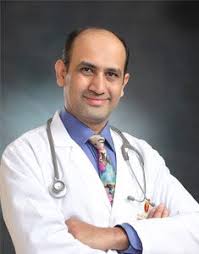
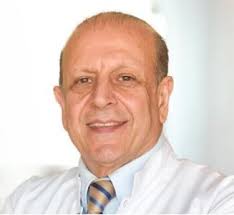
.jpg)
